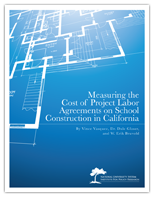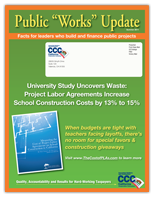Project Labor Agreements on California School Construction Raise Costs up to 15 Percent, Study Says
According to a new study released by the National University System Institute for Policy Research (NUSIPR), California school construction projects built using project labor agreements (PLAs) experienced increased costs of 13 percent to 15 percent, or $28.90 to $32.49 per square foot, compared to projects that did not use a PLA.
Measuring the Cost of Project Labor Agreements on School Construction in California (Vince Vasquez, Dr. Dale Glaser, and W. Erik Bruvold; 2011) examined the inflation-adjusted square foot construction costs for 551 school projects in California built between 1995 and 2009 – a dataset more than four times larger than any previous similar study, such as the three studies examining the impact of PLAs on school construction costs in Mass., Conn., and NY by the Beacon Hill Institute at Suffolk University in Boston, which also found that there is a statistically robust correlation between PLAs and greater school construction costs when compared to school projects constructed without a PLA.
The findings of the NUSIPR study are particularly important because California voters have approved $64 billion in school construction bonds during the past decade and several school districts have adopted the use of PLAs on these projects.
“This study, the largest and most comprehensive to date, provides new insight into the fiscal impact of PLAs,” said Vince Vasquez, NUSIPR senior policy analyst and co-author of the report. “It is our hope that our findings inform public debate when PLAs are advanced as a costless policy tool. Our research suggests they are not. Should districts choose to adopt them, school construction costs are likely to rise significantly.”
TheTruthAboutPLAs.com has long maintained that anti-competitive government-mandated PLAs are special interest schemes that end open, fair and competitive bidding on public works projects. PLAs drive up the cost of construction by reducing competition and discouraging qualified merit shop contractors and their skilled employees from building projects paid for by their own tax dollars.
Typical PLAs are pre-hire contracts that require projects be awarded only to contractors and subcontractors that agree to:
- recognize unions as the representatives of their employees on that job
- use the union hiring hall to obtain workers
- obtain apprentices exclusively from union apprenticeship programs
- pay into underfunded and mismanaged union pension and benefit plans
- obey costly, restrictive and inefficient union work rules
Study Criticized by PLA Proponents
The AFL-CIO Building and Construction Trades Department – staunch advocates and beneficiaries of anti-competitive and costly government-mandated PLA schemes – attacked the study’s findings, citing arguments by a proponent of PLAs, Dr. Dale Belman of Michigan State University’s School of Labor and Industrial Relations (see Belman’s CV and previous coverage). Belman claimed that the study overlooked important factors that affect school construction costs.
In response, the study’s authors noted during a July 22 press conference the NUSPIR study used methods to control for factors that might have increased costs that could not have been attributed to the PLA, such as the numbers of stories, where the school was built and the presence of swimming pools and gymnasiums. NUSIPR also responded to Belman’s critique in this July 25 news release.
Adding credibility to the study’s methodology and findings, the Keston Institute for Public Finance and Infrastructure Policy at the University of Southern California performed an independent review of the study and endorsed the statistical analysis and associated findings:
“Overall, we believe that the conclusion drawn in the report regarding the influence of PLAs on project cost are supported by the data set provided to us and the subsequent statistical analysis of that data,” said Richard G. Little, AICP, Director of The Keston Institute. “The research team appropriately utilized well-accepted statistical methods to arrive at this conclusion and it constitutes an important research finding. However, I would like to reiterate at this time that the results of our review should in no way be construed as the Keston Institute for Public Finance and Infrastructure Policy supporting any position relating to the use of Project Labor Agreements by any public or private entity.”
There is little doubt that academic experts will continue to vigorously debate relevant study methodologies and the overall value and cost implications of government-mandated PLAs on construction projects (for example, take a look at how Dr, David Tuerck from the Beacon Hill Institute at Suffolk University in Boston dissects Congressional testimony provided by PLA advocate and University of Utah Professor Dr. Peter Phillips in a recent Congressional hearing).
Study Renews PLA Debate
The study, covered by the San Diego papers here and here, renewed the debate about government-mandated PLAs on California construction projects funded by taxpayer dollars.
The San Diego Union Tribune reported that PLA proponent Tom Lemmon, business manager for the San Diego local trades council, admitted that PLAs do not save money when asked to comment about the study:
“You could study this thing to death,” said Lemmon, an asbestos worker. “PLAs do not raise the cost of projects. We are not saying they save money either, but they bring the projects in on time and on budget because of a more coordinated workforce.”
An op-ed published in the Sacramento Bee from Eric Hogue, a talk show host on KTKZ (1380 AM) in Sacramento and vice president of advancement at William Jessup University, argues that public officials should evaluate contractors on merit, rather than whether or not they are willing to sign a union-favoring PLA that only benefits Big Labor’s special interests (“Viewpoints: Exposing California’s costly school construction secret,” 6/22/11):
Given this data, if I were in charge of a school district, here is what I would do. If we needed to build a new school or modernize an existing facility, I would encourage all contractors to bid on the project. I would prohibit any discrimination against union contractors or other licensed construction firms. And I’d make sure that every bidder was evaluated on the merits of their proposal, the history of their performance and the benefit to my teachers, students and taxpayers who are paying the bills.
To my conservative friends, I’d say, “I’m hiring union” if their bid was best. And to my liberal friends, I’d say, “sorry, can’t work with you this time” if another contractor was the best choice. That’s the point. Political ideology has no business in anything other than history books. And that’s the biggest benefit of the national study. It’s all about dollars and cents.
The study also inspired The Flash Report’s John Fleishman’s call for fair and open competition on school construction projects (“Checkmate: University Study Makes the Case Against Project Labor Agreements,” 7/25/11)::
I would encourage every education official to think long and hard about enacting these mandated waste agreements and tell any voter to reject a school bond, UNLESS, there is written language that states there will be no project labor agreement tied to any of the funds. If the unions earn the work by providing the best bid, then that’s fine. But forcing taxpayers to spend millions more than necessary at the same time as we’re pink-slipping teachers and talking about shortening the school year is flat wrong.
This report is required reading for anyone who cares about schools or the state’s budget challenges. It’s full of good data that should serve as the foundation for a statewide campaign to ensure all public dollars spent for school construction are allocated through a competitive bidding process that is open to all licensed and qualified contractors.
 The Associated Builders and Contractors California Cooperation Committee — which supported the study with a grant to defray about 20 percent of the study’s extensive research costs according to NUSIPR estimates — plans to educate public officials about the study’s findings through a direct mail piece to California’s construction stakeholders.
The Associated Builders and Contractors California Cooperation Committee — which supported the study with a grant to defray about 20 percent of the study’s extensive research costs according to NUSIPR estimates — plans to educate public officials about the study’s findings through a direct mail piece to California’s construction stakeholders.
Review the study at TheCostofPLAs.org.
Check back with www.TheTruthAboutPLAs.com and www.facebook.com/theTruthAboutPLAs for more coverage and analysis as this study gains more attention.
Review TheTruthAboutPLAs.com’s analysis on the latest anti-PLA mandate research here and review all studies opposing government-mandated PLAs here.
May 18, 2012 update: Check out coverage of a public appearance by the study’s author here. It drew protests from Big Labor and PLA mandate proponents.











